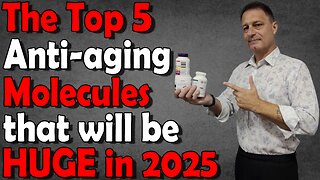Premium Only Content

2022 Research: A 16 Year Younger Biological Age; What Type of Walking?🚶🚶
A new study out of the University of Leicester has shown a link between the speed at which we walk and the speed at which our telomeres get shorter.
DoNotAge.org 10% Discount Code: MYNMN (https://bit.ly/2VBDgNt)
Renue by Science 10% Discount Code: MYNMN (https://bit.ly/350ahYM)
I hope you enjoy my content and find it interesting or informative, hopefully both, if so, please consider supporting the channel by signing up to the one you prefer:
*Buy me a Kofi: https://ko-fi.com/mynmnexperiment
*Patreon: https://bit.ly/3hhfjl5
*Subscribestar: https://bit.ly/3psYo23
My Current Anti-Aging Protocol:
• 1.5 grams of NMN (https://bit.ly/3c2Fxt8)
• 1.5 grams of Trans-resveratrol (Tue, Thu & Sat) (https://bit.ly/3yxeqy2)
• 1.5 grams of Berberine (https://bit.ly/3O0v5zq)
• 1.5 grams of TMG (https://bit.ly/3oe1Ted)
• 5,000 IU (International Units) of vitamin D3 (https://bit.ly/3P32hYH)
• 120 mcg (micrograms) of vitamin K2 (Mk 7) (https://bit.ly/3PhkBgn)
• 250mg Magnesium (L-Threonate) (https://bit.ly/3O4pZ5o)
• 200mg high molecular weight hyaluronic acid (https://bit.ly/3P0Z4c2)
• 2,400mg of Fisetin, on the 1st, 2nd & 3rd of each month (https://bit.ly/3P2rSB0)
• 2,400mg of Quercetin, on the 1st, 2nd & 3rd of each month (https://bit.ly/3IzulAy)
• 81mg of aspirin (https://bit.ly/3uFjtem)
https://www.nature.com/articles/s42003-022-03323-x
https://pubmed.ncbi.nlm.nih.gov/35444173/
https://www.researchgate.net/publication/360078941_Investigation_of_a_UK_biobank_cohort_reveals_causal_associations_of_self-reported_walking_pace_with_telomere_length
https://www.news-medical.net/news/20220505/Scientists-investigate-the-association-between-walking-pace-and-leucocyte-telomere-length.aspx
A Leicester-based team of researchers confirmed a causal link between walking pace and leucocyte telomere length (LTL), an indicator of biological age. The researchers estimated that a lifetime of brisk walking could lead to the equivalent of 16 years younger biological age by midlife. “Causal Associations of Self-Reported Walking Pace with Telomere Length” was published in Communications Biology. Whilst at the National Institute for Health Research (NIHR) Leicester Biomedical Research Center, Researchers from the University of Leicester studied genetic data from 405,981 middle-aged UK Biobank participants, they found that a faster walking pace, independent of the amount of physical activity, was associated with longer telomeres.
For those that don’t know, Telomeres are the "caps" at the end of each chromosome, they hold repetitive sequences of non-coding DNA that protect the chromosome from damage. They perform much the same function as an aglet; an aglet is the small piece of plastic or metal at the end of a shoelace that stops it from unraveling.
Each time a cell divides, these telomeres become shorter, until they become so short that the cell can no longer divide, this is known as "replicative senescence." For this reason scientists consider LTL a strong marker for "biological age," independent from when an individual was born.
Although the relationship between telomere length and disease is not fully understood, the build-up of these senescent cells is believed to contribute to a range of symptoms we associate with aging, such as frailty and age-related diseases. While the physical, mental, health and social benefits of walking are very well-documented, this study is one - of the first of its kind - to compare genetic data with self-reported walking speeds
As well as actual measurements of movement intensity, from activity tracking devices worn by the participants.
Dr. Paddy Dempsey, a Lecturer and Research Fellow at the University of Leicester, and lead author said "Previous research on associations between walking pace, physical activity and telomere length has been limited by inconsistent findings and a lack of high-quality data. This research uses genetic data to provide stronger evidence for a causal link between faster walking pace and longer telomere length. Data from wrist-worn wearable activity tracking devices used to measure habitual physical activity also supported a stronger role of habitual activity intensity (e.g. faster walking) in relation to telomere length. This suggests measures such as a habitually slower walking speed are a simple way of identifying people at greater risk of chronic disease or unhealthy aging.
DISCLAIMER: This video and description contain discount codes, which means that if you use the code, I will receive a small commission.
FAIR-USE COPYRIGHT DISCLAIMER
Copyright Disclaimer Under Section 107 of the Copyright Act 1976, allowance is made for "fair use" for purposes such as criticism, commenting, news reporting, teaching, scholarship, and research. Fair use is a use permitted by copyright statute that might otherwise be infringing. Non-profit, educational, or personal use tips the balance in favor of fair use.
#steps #walking #stepsaday
-
 6:07
6:07
My Longevity Experiment
8 months ago $0.05 earnedTop 5 Longevity Supplements for 2025 | A Data Driven List
1583 -
 LIVE
LIVE
Badlands Media
8 hours agoBaseless Conspiracies Ep. 147
16,643 watching -
 2:55:23
2:55:23
TimcastIRL
3 hours agoTrump Orders Specialized National Guard Units To Combat Crime In Cities, Dems Furious | Timcast IRL
141K85 -
 LIVE
LIVE
SpartakusLIVE
5 hours ago#1 Rocket CHAMPION of Verdansk wields UNSTOPPABLE new META
1,003 watching -
 2:55:11
2:55:11
Barry Cunningham
4 hours agoPRESIDENT TRUMP MADE TODAY A VERY BAD DAY TO BE A DEMOCRAT!
50.3K33 -
 DVR
DVR
Flyover Conservatives
22 hours agoFrom Cool to Cringe: How Democrats Lost America’s Ear | FOC Show
13.5K3 -
 8:19
8:19
MattMorseTV
8 hours ago $2.90 earnedTrump is ACTUALLY DOING IT.
13.6K28 -
 LIVE
LIVE
ZWOGs
10 hours ago🔴LIVE IN 1440p! - Tarkov w/ Casey & crgoodw1n, Kingdom Come Deliverance, & More - Come Hang Out!
147 watching -
 LIVE
LIVE
We Like Shooting
14 hours agoWe Like Shooting 625 (Gun Podcast)
167 watching -
 1:45:02
1:45:02
Glenn Greenwald
5 hours agoIsrael Slaughters More Journalists, Hiding War Crimes; Trump's Unconstitutional Flag Burning Ban; Glenn Takes Your Questions | SYSTEM UPDATE #504
100K118